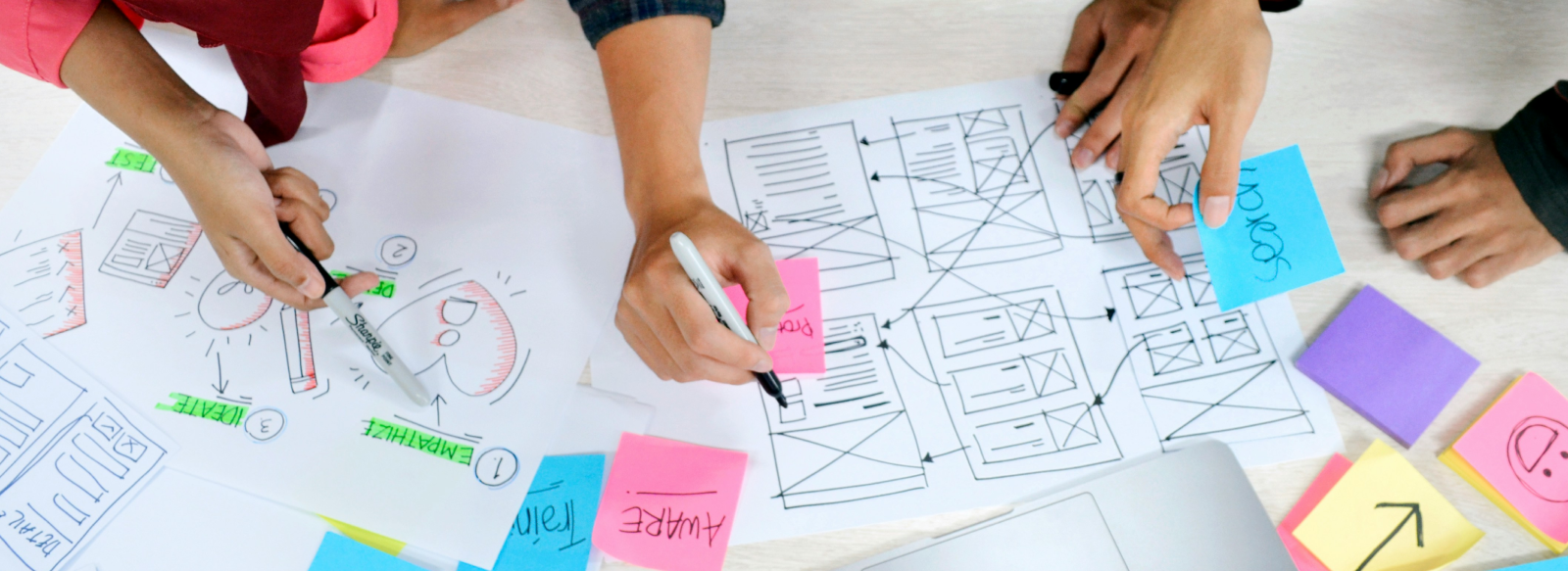Imagine building a skyscraper. You’ve got your blueprints, tools, and a team ready to go. But what if I told you that in the world of business, there’s something akin to constructing these giants of steel and glass? That’s where we dive into what is the meaning of enterprise design. It’s about piecing together a complex puzzle where every part must fit perfectly—only instead of girders and concrete, it’s strategies and systems.
This isn’t just another buzzword; it’s the bedrock for innovation within today’s most successful companies. Like architects who transform landscapes with towering edifices, this process reshapes how businesses operate at their core.
I once walked through an office space so intuitively designed that productivity seemed baked into its very walls—this was no accident but the result of meticulous enterprise design.
You’re on the brink of uncovering secrets like these: How do diverse teams fuel breakthrough solutions? What does restless reinvention look like in practice? By sticking around here, you’ll dive into insights that can transform your approach and spur innovation. Get ready to explore powerful strategies that top performers use to stay ahead.
The Essence of Enterprise Design
Picture a skyscraper. Now imagine trying to design each floor with different teams who don’t talk to each other. Sounds like chaos, right? That’s where enterprise design comes into play—it’s the blueprint for building business solutions that make sense together and stand tall in the competitive landscape.
Defining Enterprise Design
To get what enterprise design really means, think about it as the art and science of crafting large-scale business strategies. It goes beyond pretty interfaces; we’re talking serious problem-solving here—aligning user needs with technical feasibility and business viability. Remember Richard Buchanan’s take on wicked problems in design thinking? Well, it’s all about taming those beasts by focusing on brand differentiation while zeroing in on creating tangible user outcomes.
If you’ve heard buzzwords like ‘enterprise architecture’ or ‘enterprise UX,’ they’re not just fancy terms but crucial elements common across businesses aiming for breakthrough solutions.
Core Principles Behind The Buzz
Digging deeper into this world often leads us to IBM’s playground—they’ve been major players shaping how companies tackle these challenges through their own flavour of IBM enterprise design thinking. Their approach hinges on three main pillars: stellar user experience, relentless reinvention, and fostering diverse empowered teams that can shake up traditional models while delivering high-value scenarios that resonate with real users.
Enterprise Design through Purposeful Process and Methodology
In practice, this isn’t your average brainstorm session over coffee (although caffeine certainly doesn’t hurt). It involves an iterative process where ideas are constantly refined based on feedback loops from actual sponsor users—the folks who will live with your creation day in and day out.
This method turns vague notions into concrete plans—a hill represents more than a goal; it becomes a guiding principle helping teams work towards meaningful change within their business domain using an arsenal ranging from style guides to full-fledged capability models crafted by savvy enterprise architects itching for some architectural action.
Driving Business Success with Enterprise Design
A huge part of nailing this gig lies in understanding the complex terrain of corporate ecosystems—you need to speak fluent ‘business language’ if you want your designs to thrive rather than merely survive. Think along lines such as customer service improvements meshed seamlessly within existing processes—or envisioning new ways services can evolve without derailing current operations—that’s high-level stuff making big waves across boardrooms worldwide because it translates directly into enhanced customer experiences… Cha-ching.
Key Takeaway:
Enterprise design is your blueprint for building business solutions that click together, stand out in the market, and tackle those tough problems head-on. It’s more than looks; it’s about aligning what users want with what’s technically possible and profitable.
Dive into enterprise design like IBM does: focus on top-notch user experiences, constant innovation, and teams ready to mix things up. Through an iterative process with real feedback from users, vague ideas turn into solid strategies for meaningful change.
To ace enterprise design, you gotta speak ‘business’ fluently—meld customer service upgrades smoothly within existing operations or cook up new services without flipping the whole table over.
Principles of IBM’s Approach to Enterprise Design
IBM has turned the enterprise design world on its head, and it’s not by playing it safe. They’ve tossed out the cookie-cutter approach and baked a whole new pie with their version of enterprise design thinking.
Core Principles of IBM’s Methodology
If you think traditional design is all about making things look pretty, IBM will have you doing a double-take. Their methodology isn’t just skin-deep; it digs into the marrow of user experience, insists on restless reinvention like a kid in a candy store who can’t choose just one treat, and champions diverse teams that bring more flavours to the table than an international buffet.
The secret sauce? A trio that packs quite the punch: focusing keenly on user outcomes for starters because let’s face it—what good is any service if people don’t want or need to use it?
We’re talking about teams so empowered they could probably run their own small countries. These folks aren’t stuck in cubicles; they’re crossing boundaries faster than tourists at open borders. But diversity here isn’t your typical corporate speak—it means bringing together minds as varied as New York City subway cars during rush hour.
This mélange leads us down paths where few dare tread—the thrilling road of relentless innovation—a place where comfort zones are popped like bubble wrap underfoot at every step. The goal? Breakthrough solutions that leapfrog over current trends straight into tomorrow land without even breaking a sweat.
You might be nodding along now but wait until I tell you this: we’re building these solutions while keeping everyone singing from the same hymn sheet thanks to robust design systems peppered throughout our processes like well-placed emojis in texts—they make everything clearer without saying much.
Richard Buchanan once said wicked problems require innovative approaches, which pretty much sums up why IBM’s take on enterprise architecture is anything but vanilla.
You’ve got hills representing high-value scenarios carved out with precision—not random ideas thrown against walls hoping something sticks. And yes, when these elements come together under those bright fluorescent office lights (or sleek LEDs), magic happens—or should I say business change does?
So there you have it—IBM turns big ship steering from daunting tasks akin to turning around aircraft carriers single-handedly into smooth sailing adventures guided by stars named User Experience, Restless Reinvention, and Diverse Empowered Teams.
Key Takeaway:
IBM shakes up enterprise design by ditching the old playbook for a fresh, user-focused approach that thrives on continuous innovation and dynamic teams. It’s all about creating solutions today that solve tomorrow’s problems—making magic in the business world with precision and creativity.
Building on Design Thinking Basics for Enterprise Success
Picture this: you’re piecing together a massive jigsaw puzzle called ‘enterprise-level projects’. The edges are your business capabilities, the corners are your guiding principles, and every single piece in between is steeped in user experience. This isn’t just any old puzzle; it’s one that requires design thinking to make all pieces fit seamlessly.
Scaling Traditional Design Thinking Principles
In an enterprise setting, design thinking isn’t confined to creative studios—it’s the heartbeat of innovation across complex business landscapes. We’re talking about pushing beyond pretty interfaces and cool features; we’re zeroing in on customer service experiences so intuitive that users might wonder if telepathy was involved. But how do we get there? It starts by expanding traditional design methods to match the heft of enterprise challenges.
Sure, start-ups can pivot faster than a cat chasing its tail because their scale is small—but enterprises need something more robust for breakthrough solutions. Imagine leveraging diverse empowered teams where each person brings something unique to the table—whether it’s insight into high-value scenarios or architectural know-how from those elusive sponsor users who always seem two steps ahead.
The secret sauce lies within empowering these teams with clear targets (like hill’s specific goals) and fostering an environment ripe for restless reinvention. When IBM talks about IBM Enterprise Design Thinking, they’re not just blowing hot air—they’ve crafted core principles designed specifically for such herculean tasks as building scalable systems while keeping an eye on user outcomes like hawks circling their prey.
Crafting User Personas for Targeted Solutions
Dive deep enough into enterprise UX design, and you’ll find yourself face-to-face with personas so detailed they could apply for passports. Why? Because creating solutions without knowing whom they’re for is like trying to hit a bullseye blindfolded—possible but wildly impractical. By defining user personas upfront, designers lay down tracks toward meaningful interactions tailored perfectly around actual needs rather than guesswork or assumptions pulled out of thin air.
Gathering feedback loops tighter than granny knots ensures our creations aren’t off-target shots in the dark but finely-tuned instruments calibrated through real-world use cases—from folks hammering away at keyboards inside corporate behemoths right down to individuals thumb-swiping through apps during coffee breaks.
Fusing Business Language With Experience Design
A little birdie told me (okay fine—it was hours spent wrestling with complex data models) that marrying business language with experience design makes powerful offspring indeed. Enterprises live by acronyms and buzzwords, but when you blend them seamlessly into user-centric designs, magic happens. This synergy drives innovation and creates experiences that not only resonate with users but also achieve strategic business goals.
Key Takeaway:
Design thinking in enterprise isn’t just for show—it’s the core of innovation, transforming hefty challenges into intuitive customer experiences. It calls for diverse teams with unique insights and a knack for constant reinvention, all aimed at crafting user-centered solutions that hit the mark every time.
Enhancing User Experience Through Design Elements
You know the drill. You’re using an app or a website, and something just clicks. It’s smooth sailing—like that feeling when you glide through green lights on your morning commute. That, my friends, is no accident; it’s by design—a user-centric design to be exact.
Crafting User Personas for Targeted Solutions
We ain’t just throwing stuff at the wall here; we’re aiming for that bullseye. Creating solutions starts with knowing who you’re aiming for—the users. Now imagine those users are characters in a movie where your product is the star—they need depth, motivations, quirks even. These personas guide us away from generic traps and toward experiences tailored like a bespoke suit.
It’s all about diving deep into their world—user-centric sessions help peel back layers revealing real needs and wants because let’s face it: assuming what folks want is as risky as texting while scooting down Main Street during rush hour.
Incorporating feedback isn’t just polite—it’s essential—as vital as coffee beans to a barista. We ask questions until there’s nothing left but clear skies of understanding then iterate faster than late-night infomercials promise life-changing gadgets can do stuff.
Why so much fuss? Because this ain’t small potatoes—it affects everything downstream from customer service interactions to how sponsor users advocate for your cause within their own tribes (read: companies).
User-Centric Sessions – The Secret Sauce?
Gather ‘round team members across departments—we’re breaking silos like piñatas at birthday parties. See, these user-focused gatherings aren’t stale PowerPoint marathons; they’re dynamic brainstorm fests fuelled by diversity of thought. And yeah—that includes hearing directly from diverse empowered teams made up of people who reflect our end-users’ kaleidoscope backgrounds.
The Power of Feedback Loops
Straight-up fact: great ideas don’t grow on trees—but they might sprout up in well-fertilized feedback loops. Imagine tossing seeds (ideas) out into the wild (the market), waiting eagerly only to find crickets chirping instead of flowers blooming—you missed watering them with insights straight from the source.
Note: This post was written based on first-hand experience working within enterprise UX design agencies where continuous learning cycles fuel innovation – essentially putting theories such as IBM Enterprise Design Thinking Principles into practice daily.
Richard Buchanan once said, “Wicked problems demand inventive solutions,” and he couldn’t have been more right especially when talking about enhancing user experience through smart.
Key Takeaway:
Design that makes you feel like you’ve hit every green light? That’s user-centric design in action. It’s all about crafting personas with as much care as a tailor takes over a bespoke suit, diving into users’ worlds to avoid assumptions, and iterating solutions based on real feedback—because knowing your users isn’t just nice, it’s crucial.Ever seen silos smashed at team gatherings? User-centric sessions are where the magic happens, breaking down walls with diverse ideas that reflect our kaleidoscope of users. And remember: great ideas need nurturing—with feedback loops acting like water for seeds (ideas) waiting to bloom into innovation.
Essential Enterprise Design Trends
1. User-Centric Design:
Prioritizing the user experience remains paramount. Tailoring enterprise applications to be intuitive and user-friendly boosts productivity and user satisfaction across the board.
2. Collaborative Design Tools:
With the shift towards remote work, there’s a clear need for design tools that foster real-time collaboration. Such tools allow designers, developers, and stakeholders to work closely and efficiently, ensuring alignment and swift iterations.
3. Accessibility and Inclusivity:
Embracing accessibility in design is no longer optional but essential. Creating inclusive designs ensures that all users, including those with disabilities, can access and use enterprise products and services effectively.
4. Data-Driven Design:
Using data to inform design decisions is becoming standard practice. By analyzing user behavior and feedback, enterprises can refine their designs to better meet user needs and enhance engagement.
5. Adaptive and Responsive Design:
As the range of devices and screen sizes continues to expand, designing interfaces that adapt and respond to different devices is crucial. This ensures a consistent and optimized user experience across various platforms.
6. Ethical Design Practices:
Transparency, privacy, and responsible use of data are gaining prominence in design practices. Enterprises increasingly focus on ethical considerations to build trust and maintain a positive reputation among users.
7. Modular and Scalable Design Systems:
Modular design systems allow enterprises to maintain consistency across their products and services. These systems enable faster and more efficient design iterations, ensuring scalability and adaptability to evolving business needs.
FAQs in Relation to What is the Meaning of Enterprise Design?
What does an enterprise designer do?
An enterprise designer crafts strategic designs that bridge the gap between a company’s goals and user needs, focusing on innovation.
What is an enterprise design system?
It’s a set of standards for unifying product teams around common visual language and UX guidelines in large-scale organizations.
What best describes enterprise design thinking?
This approach to problem-solving prioritizes user outcomes, leverages diverse teams, and aims for continuous improvement at scale.
What are the three principles of enterprise design?
The trio driving this concept: centering around human experiences, fostering collaborative innovation, and ensuring solutions adapt over time.
Conclusion
So, what is the meaning of enterprise design? It’s a blueprint for business innovation. Just as architects draw plans for skyscrapers, designers craft strategies and systems to elevate companies.
Dive in, and you’ll discover that diverse teams are not just a box-ticking exercise; they’re essential to creative breakthroughs. Restless reinvention isn’t merely change for change’s sake—it’s about continuous improvement.
Remember these pillars: user-centric solutions keep customers coming back; architectural frameworks guide your strategic build-out; IBM’s principles offer fresh perspectives on scaling ideas. Embrace this knowledge—your business can stand tall like those glass giants against any challenge.




